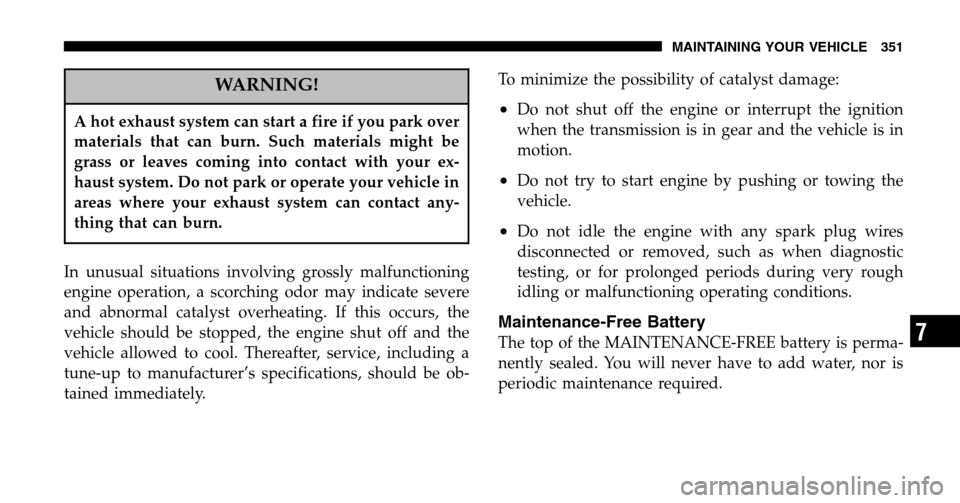Page 330 of 440

2. Slow down if road has standing water or puddles.
3. Replace tires when tread wear indicators first become
visible.
4. Keep tires properly inflated.
5. Maintain sufficient distance between your vehicle and
the vehicle in front to avoid a collision in a sudden stop.
FREEING A STUCK VEHICLE
If your vehicle becomes stuck in mud, sand or snow, it
can often be moved by a rocking motion. Turn your
steering wheel right and left to clear the area around the
front wheels. Then shift back and forth between Reverse
and Drive. Usually the least accelerator pedal pressure to
maintain the rocking motion without spinning the
wheels is most effective.
WARNING!
Fast spinning tires can be dangerous. Forces gener-
ated by excessive wheel speeds may cause tire dam-
age or failure. A tire could explode and injure
someone. Do not spin your vehicle’s wheels faster
than 35 mph (55 km/h) when you are stuck. And
don’t let anyone near a spinning wheel, no matter
what the speed.
CAUTION!
Racing the engine or spinning the wheels too fast
may lead to transmission overheating and failure. It
can also damage the tires. Do not spin the wheels
above 35 mph (55 km/h).
330 WHAT TO DO IN EMERGENCIES
Page 350 of 440
Catalytic Converter
The catalytic converter requires the use of unleaded fuel
only. Leaded gasoline will destroy the effectiveness of the
catalyst as an emission control device.
Under normal operating conditions, the catalytic con-
verter will not require maintenance. However, it is im-
portant to keep the engine properly tuned to assure
proper catalyst operation and prevent possible catalyst
damage.CAUTION!
Damage to the catalytic converter can result if your
vehicle is not kept in proper operating condition. In
the event of engine malfunction, particularly involv-
ing engine misfire or other apparent loss of perfor-
mance, have your vehicle serviced promptly. Contin-
ued operation of your vehicle with a severe
malfunction could cause the converter to overheat,
resulting in possible damage to the converter and the
vehicle.
NOTE: Intentional tampering with emissions control
systems can result in civil penalties being assessed
against you.
350 MAINTAINING YOUR VEHICLE
Page 351 of 440

WARNING!
A hot exhaust system can start a fire if you park over
materials that can burn. Such materials might be
grass or leaves coming into contact with your ex-
haust system. Do not park or operate your vehicle in
areas where your exhaust system can contact any-
thing that can burn.
In unusual situations involving grossly malfunctioning
engine operation, a scorching odor may indicate severe
and abnormal catalyst overheating. If this occurs, the
vehicle should be stopped, the engine shut off and the
vehicle allowed to cool. Thereafter, service, including a
tune-up to manufacturer’s specifications, should be ob-
tained immediately. To minimize the possibility of catalyst damage:
•Do not shut off the engine or interrupt the ignition
when the transmission is in gear and the vehicle is in
motion.
•Do not try to start engine by pushing or towing the
vehicle.
•Do not idle the engine with any spark plug wires
disconnected or removed, such as when diagnostic
testing, or for prolonged periods during very rough
idling or malfunctioning operating conditions.
Maintenance-Free Battery
The top of the MAINTENANCE-FREE battery is perma-
nently sealed. You will never have to add water, nor is
periodic maintenance required.
MAINTAINING YOUR VEHICLE 351
7
Page 361 of 440

The use of lower quality water will reduce the amount of
corrosion protection in the engine cooling system.
Please note that it is the owner’s responsibility to main-
tain the proper level of protection against freezing ac-
cording to the temperatures occurring in the area where
the vehicle is operated.
NOTE: Mixing coolant types will decrease the life of the
engine coolant and will require more frequent coolant
changes.
Cooling System Pressure Cap
The cap must be fully tightened to prevent loss of
coolant, and to insure that coolant will return to the
radiator from the coolant recovery bottle.
The cap should be inspected and cleaned if there is any
accumulation of foreign material on the sealing surfaces.
WARNING!
•The warning words “DO NOT OPEN HOT” on
the cooling system pressure cap are a safety pre-
caution. Never add coolant when the engine is
overheated. Do not loosen or remove the cap to
cool an overheated engine. Heat causes pressure
to build up in the cooling system. To prevent
scalding or injury, do not remove the pressure cap
while the system is hot or under pressure.
•Do not use a pressure cap other than the one
specified for your vehicle. Personal injury or
engine damage may result.
MAINTAINING YOUR VEHICLE 361
7
Page 426 of 440

Electric Remote Mirrors.................... 82
Electrical Power Outlets ................... 152
Electronic Speed Control (Cruise Control) ...... 138
Electronic Vehicle Information Center (EVIC) .... 176
Emergency, In Case of Hazard Warning Flasher ................. 318
Jacking ............................. 320
Jump Starting ......................... 327
Overheating .......................... 319
Emission Control System Maintenance ......341,390
Engine ............................ 338,339
Air Cleaner .......................... 349
Air Cleaner Filter ...................... 349
Block Heater ......................... 260
Break-In Recommendations ................ 71
Checking Oil Level ..................... 344
Compartment ...................... 338,339
Coolant (Antifreeze) .................... 387
Cooling ............................. 358 Exhaust Gas Caution
.................. 31,299
Fails to Start .......................... 259
Fuel Requirements .................. 296,386
Oil ........................... 344,386,387
Oil Change Interval .................... 345
Oil Disposal .......................... 348
Oil Filler Cap ...................... 346,347
Oil Filter Disposal ...................... 348
Oil Selection ....................... 346,386
Oil Synthetic ......................... 348
Overheating .......................... 319
Temperature Gauge ..................... 168
Exhaust Gas Caution ..............31,71,299,358
Exhaust System ......................... 357
Extender, Seat Belt ........................ 44
Exterior Folding Mirrors ................... 80
Filters Air Cleaner .......................... 349
426 INDEX
Page 432 of 440

Occupant Restraints....................... 33
Octane Rating, Gasoline (Fuel) .............. 296
Odometer ............................. 172
Oil, Engine ......................... 344,387
Capacity ............................ 386
Change Interval ....................... 345
Checking ............................ 344
Disposal ............................ 348
Filter ............................ 348,387
Filter Disposal ........................ 348
Identification Logo ..................... 346
Materials Added to ..................... 348
Recommendation ................... 346,386
Synthetic ............................ 348
Viscosity ....................... 346,347,386
Onboard Diagnostic System ..............340,341
Opener, Garage Door (HomeLink �) ........... 142
Operator Manual (Owner’s Manual) ............ 4
Overdrive ............................. 264 Overhead Console
....................... 141
Overhead Travel Information Center .......... 141
Overheating, Engine ................... 168,319
Owner’s Manual (Operator Manual) .........4,418
Panic Alarm ............................ 22
Parking Brake .......................... 266
Parking On Hill ......................... 267
Passing Light ........................... 130
Pedals, Adjustable ....................... 137
Pets, Transporting ........................ 70
Phone, Cellular .......................... 83
Phone, Hands-Free (UConnect™) ............. 83
Placard, Tire and Loading Information ......... 278
Power Brakes .............................. 268
Distribution Center ..................... 377
Door Locks ........................... 17
Lift Gate ............................. 29
432 INDEX